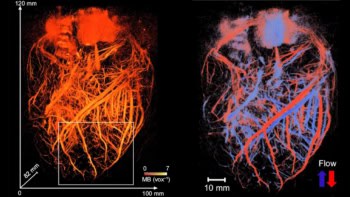
A wearable ultrasound device can provide 48 hours of continuous imaging of internal organs while patients go about their daily lives. The device – developed by a team headed up at Massachusetts Institute of Technology (MIT) – consists of a rigid piezoelectric ultrasound array that sticks to the skin via a soft bioadhesive hydrogel–elastomer hybrid. Describing their findings in Science, the researchers demonstrate that the patch can image the heart, gastrointestinal tract, diaphragm and lungs during activities such as jogging or drinking fluids.
Ultrasound is one of the most widely used tools for medical imaging, but it has its limitations. Ultrasonic imaging uses bulky and specialized equipment and requires trained sonographers to position the transducer on the patient’s body. This generally limits its use to short, static sessions.
In recent years there have been significant developments in wearable devices for continuous and non-invasive medical monitoring. While such devices have successfully measured physiological data such as heart rhythm and electrical activity, and metabolites and electrolytes in sweat from the skin, clinical grade imaging of internal organs has proved challenging.
“A wearable ultrasound imaging tool would have huge potential in the future of clinical diagnosis,” explains first author Chonghe Wang, an MIT graduate student. “However, the resolution and imaging duration of existing ultrasound patches is relatively low, and they cannot image deep organs.”
Previous wearable ultrasound devices have tended to rely on stretchable transducer arrays. While these can deform with the skin, this flexibility causes the transducers to move relative to each other, reducing image quality. Flexible substrates also limit the density of transducers in the array, impacting image resolution. There have also been issues with the adhesives remaining attached to the skin and dampening the ultrasound signal.
The new device developed by Wang and colleagues contains a thin and rigid ultrasound probe, consisting of a high-density array of piezoelectric elements, that adheres to the skin via a stretchy hydrogel–elastomer hybrid. “This combination enables the device to conform to the skin while maintaining the relative location of transducers to generate clearer and more precise images,” Wang explains.
The 90% water hydrogel enables high-quality acoustic transmission to the skin, much like the gels used in a standard ultrasound exam, while the two thin elastomers that encapsulate it prevent it from drying out. Coated with bioadhesive to bond it to the rigid ultrasound probe and skin, the total thickness of the elastomer membrane and bioadhesive is less than one-quarter of the acoustic wavelength to minimize its impact on acoustic transmission. The entire patch is similar in size to a postage stamp.
Using a variety of tests, the researchers showed that the wearable device can maintain a strong adhesion to the skin for more than 48 h and withstand high pulling forces. They also used healthy volunteers to demonstrate 48-h continuous imaging of human organs. Ultrasound probes with different frequencies were used depending on the depth of the organs being imaged.
The researchers were able to continuously image the jugular vein and carotid artery in the neck during dynamic body motions such as neck rotations. They observed the diameter of the vein changing as volunteers moved from sitting or standing to lying down, and were able to measure changes in blood flow and pressure in the artery while volunteers jogged. They also imaged lung function, diaphragm movement and the four chambers of the heart before, during and after exercise such as jogging and cycling; and observed the stomach filling and emptying as volunteers drank and the juice moved through their digestive system.

Robotic exosuit uses ultrasound imaging to provide personalized walking assistance
The team is now working to make the stickers wireless and developing artificial intelligence algorithms to help interpret the images. “We imagine we could have a box of stickers, each designed to image a different location of the body,” says senior author Xuanhe Zhao. “We believe this represents a breakthrough in wearable devices and medical imaging.”
Writing in an associated perspective article, Philip Tan and Nanshu Lu caution that despite the opportunities presented by the patch there are obstacles to overcome. In particular, incorporating the extensive circuitry and hardware required to control enough transducers for 3D medical imaging could limit manoeuvrability and mobility – something that “ultrasound on a chip” research could help with.



